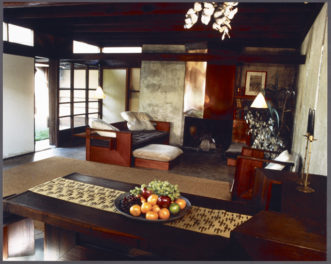
Getty Conservation Institute scientist Jim Druzik holding one of several filters being evaluated for use in conservation lighting.
Jim Druzik is obsessed with light. More particularly, he’s concerned with the destructive power of light on priceless museum treasures, and it’s his pioneering work in conservation and preservation that could protect great works of art.
Jim, a senior scientist at the Getty Conservation Institute, has for the past nine years been investigating how to mitigate light damage without compromising the museum visitor’s viewing pleasure. His work explores the nature of light and why it permanently alters the objects it touches—for example, changing the powder-blue paper of an Old Master sketch into a murky gray. His research, conducted in a windowless basement laboratory at the Getty Center, literally aims to help museum visitors see art in a whole new light.
“I’m looking to reduce the inevitable light damage caused during display by altering the lighting source in subtle yet powerful ways that have not been technically feasible until the last few years,” he told me.
Currently, most museums display light-sensitive artifacts under low levels of incandescent lighting, which means many visitors perceive less color and fewer details. It’s a trade-off: The low light helps to preserve the artifact, but it also alters the viewer’s perception of the original work of art.
Jim’s ultimate goal is to find the elusive balance between conservation, aesthetics, and visual satisfaction for the museum visitor. To that end, he has built an Experimental Lighting Facility at the Getty, dubbed “ELF,” that realistically simulates a typical museum gallery and allows his team the flexibility to control the important display variables. Track lighting lines the ceiling of the room, and museum display cases are outfitted with flexible fiber optics and radio controlled illumination levels. Framed artwork decorates the walls.
Sample viewing populations of museum professionals and volunteers have visited these rooms, evaluating via a specially designed questionnaire the perceived color differences in green-red, blue-yellow and brightness color perception scales. Under each light level, the responses to the questions change: Were details in the drawing clear? Which details stood out the most? What color is the background? These answers, and many others, will help Jim and his team in their search for perfectly filtered light.
The research, led by Jim in collaboration with his colleague Dr. Carl Dirk at the University of Texas, El Paso (UTEP), is already being utilized.
Last year, when The Georgia O’Keeffe Museum officially debuted the exhibition Georgia O’Keeffe: Abstractions, the institution was among the very first in the country to utilize the pioneering lighting research.
The Conservation Institute and the O’Keeffe Museum will also be conducting a scientific analysis of O’Keeffe’s watercolors and pastels, now housed along with the rest of her studio materials at the O’Keeffe Museum Research Center, to understand what elements they are comprised of and how light may affect them. The results will help inform how the new light filters for the O’Keeffe Museum will be designed for those items.
The lighting research is also the basis of an ongoing interactive public exhibition created in collaboration with the California Science Center. Entitled FADE: The Dark Side of Light, the 1,200-square-foot exhibition, which blends science and art, explains the nature of light and its destructive power. Through an audio and visual program, guests can zoom in and learn how light damages materials at the atomic level.
The exhibit also features a series of projected images, which first appear and then slowly fade from view. Visitors see further dramatic evidence of light damage through photographs, works of art, and a collection of everyday items. The exhibit also offers suggestions for mitigating the damage to your own personal treasures, such as family photographs.
To discover ways of mitigating the damaging effect of light, guests to the exhibition also can experiment with how certain materials reflect, transmit, or absorb electromagnetic energy. Much like the experiments conducted inside the ELF, one interactive display invites guests to illuminate paintings with selected wavelengths of light in order to compare the effects with those of full-spectrum light. A companion interactive display lets visitors explore how color and contrast affect their perception.
In the meantime, back in the basement of the Conservation Institute, Jim Druzik’s research goes on. His current area of focus is light emitting diodes, or LEDs. Due to recent technology advances, in the last three years LEDs have become prime contenders for replacing the kinds of lighting museums have used for most of the 20th century. Jim has been working with the Pacific Northwest National Laboratory (PNNL) in Portland, Oregon, as well as his colleagues at UTEP on this new research.
“We will never eliminate light damage as a factor,” he says, “but we intend to make it far more manageable.”




LEDs seem like the clear path forward as the article indicates. Since “white” sources can be made without the production of UV light (mixing of three or four color LEDs), it should be possible to sharply curtail the degradation by UV that fluorescent or “daylight” incandescent lights produce. However, some “white” LEDs use a UV emitter in conjunction with a phosphor – how much leakage of UV occurs compared to conventional fluorescent bulbs? For three and four color visible LEDs, how do the degradation rates compare?
Hi, Andy –
Thanks for your comment and interesting question! Jim Druzik had this answer:
“At the present time all white LEDs used in museums, or being contemplated for that purpose, utilize a blue LED in conjunction with a broadband white phosphor. The color rendering index for these types of lamps generally range from the mid-80s to mid-90s.
The excitation of fluorescence using an LED chip with significant UV are not used in museums. Multiband LEDs like RGB and RAGB do not have the color rendering of white LEDs. They tend to be particularly poor at rendering yellows as well as the light sources they would be replacing indoors. That is not to say that some day they may be competitive. The most common forms of white phosphor LEDs in museums not have little, if any, light below 420-440 nm and drop off beyond 660 nm, making them negligible sources of both UV and IR.”
Dear Jim,
I hopoe you don’t mind me asking some questions. I was interested to read about your studies on albumen photograph dyes. Did the LED’s have any effect on the albumen of the photographs?
1. Is a lux reading for LED lights the same as for other forms of light. Do we need to look at LED’s differently when taking loght readings?
2. Even if an LED light does not emit UV, does it still have the same light damaging effects on paper such as bleaching and or yellowing that other light forms have on paper.
3. Some lighting people say that one can use LED’s to display light sensitive media where one could not have done that in the past, but correct me if I am wrong but cutting out UV does not stop paper deteriorating?
4. What are the long term effects of LED light sources on cellulosic material, does it have the same long term effects as other light sources?
Thanks
Lisa